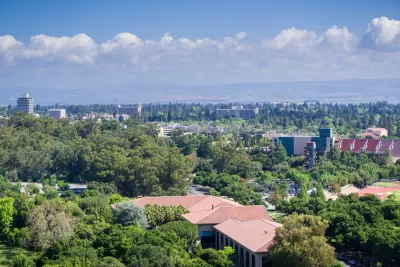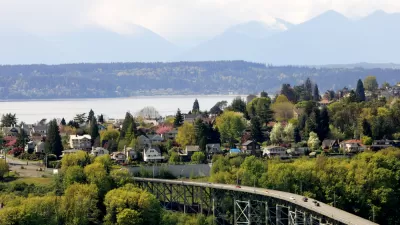To keep up with demand and slow the astronomical rise in housing costs, Palo Alto and other Silicon Valley cities must overcome local opposition to density and high-rises.

Brock Keeling argues that Palo Alto must revive its forgotten role as a housing innovator if it is to house all the workers flocking to Silicon Valley and maintain any semblance of affordable housing within the city.
In the 1950s, "famed developer Joseph Eichler, who believed that good design should be democratic, studded the city with affordable homes that, at the time, were priced to move. He used innovative and imaginative architects to bring roughly 2,700 homes with crisp lines and a focus on the outdoors to the working class." Today, "the betrayal of Eichler’s affordable and stylish vision really slaps you in the face the moment you step off the train in Palo Alto."
"Eichler’s Mid-Century Modern homes, prized for their vaulted ceilings and floor-to-ceiling windows, now regularly fetch upward of $2.5 million." The city's median price, meanwhile, is $3.5 million.
"Between 2010 and 2018 Palo Alto's jarring jobs-to-housing ratio was 16:1, with 20,475 jobs added, but only 1,269 homes permitted, according to data from the U.S. Census Bureau and the U.S. Department of Housing and Urban Development." Jordan Grimes, a Peninsula housing advocate, says "[t]he strongest force pushing back against new housing in Palo Alto is what's known as the ‘residentialist’ faction."
By mandating residential mid and high-rises, Palo Alto can become ground zero for housing that goes above — way above — its puny 50-foot ceiling for new developments, a law enacted in the early 1970s to allegedly preserve quality of life. Get rid of all parking requirements, an outdated mandate from 1951. Affix fees on new commercial builders to fund affordable housing. And increase the puny 20% affordable housing requirement while you’re at it.
"As mandated by the Association of Bay Area Governments, the Bay Area as a whole has to change its zoning to allow construction of 441,000 new homes from 2023 to 2031."
FULL STORY: Manhattanize Palo Alto

Trump Administration Could Effectively End Housing Voucher Program
Federal officials are eyeing major cuts to the Section 8 program that helps millions of low-income households pay rent.

Planetizen Federal Action Tracker
A weekly monitor of how Trump’s orders and actions are impacting planners and planning in America.

Ken Jennings Launches Transit Web Series
The Jeopardy champ wants you to ride public transit.

California Invests Additional $5M in Electric School Buses
The state wants to electrify all of its school bus fleets by 2035.

Austin Launches $2M Homelessness Prevention Fund
A new grant program from the city’s Homeless Strategy Office will fund rental assistance and supportive services.

Alabama School Forestry Initiative Brings Trees to Schoolyards
Trees can improve physical and mental health for students and commnity members.
Urban Design for Planners 1: Software Tools
This six-course series explores essential urban design concepts using open source software and equips planners with the tools they need to participate fully in the urban design process.
Planning for Universal Design
Learn the tools for implementing Universal Design in planning regulations.
Ada County Highway District
Clanton & Associates, Inc.
Jessamine County Fiscal Court
Institute for Housing and Urban Development Studies (IHS)
City of Grandview
Harvard GSD Executive Education
Toledo-Lucas County Plan Commissions
Salt Lake City
NYU Wagner Graduate School of Public Service





























